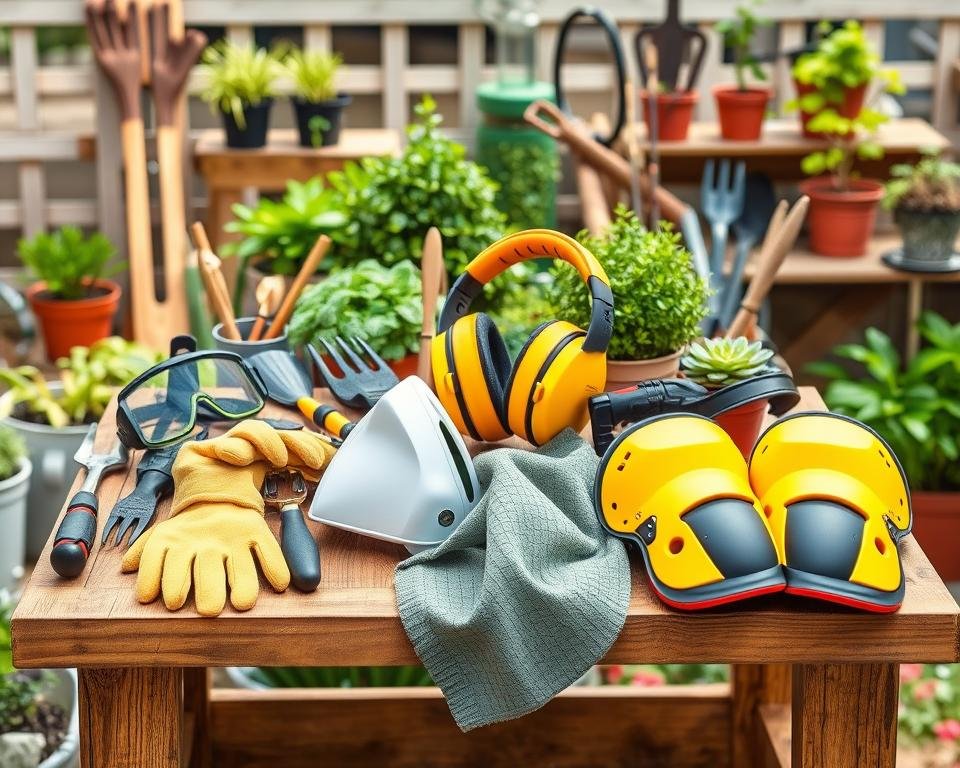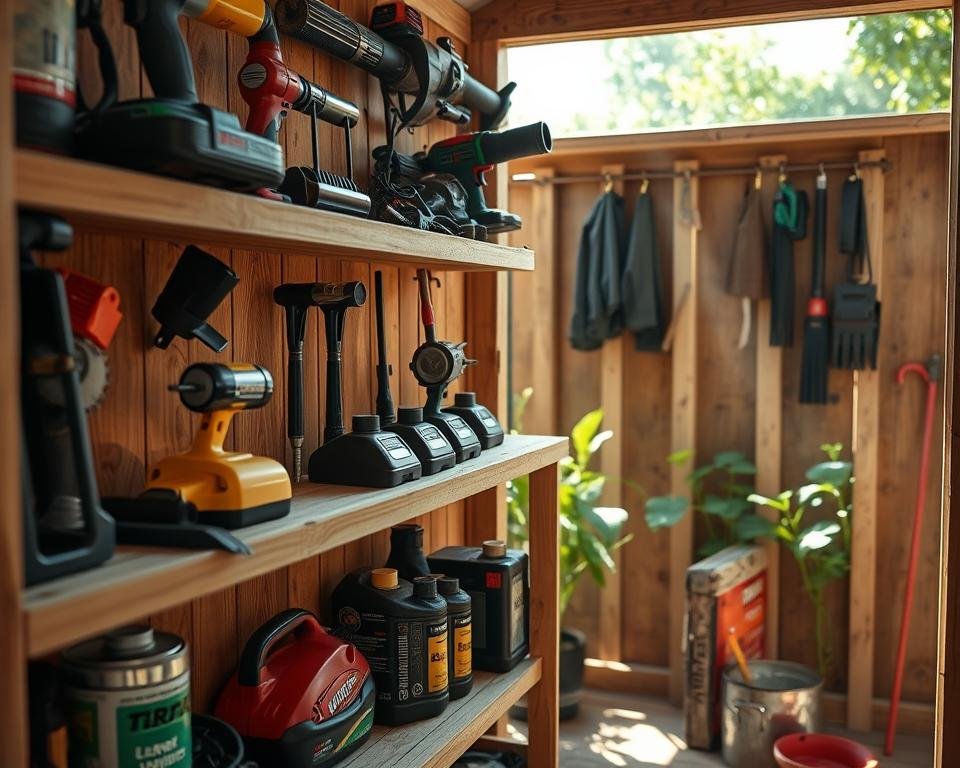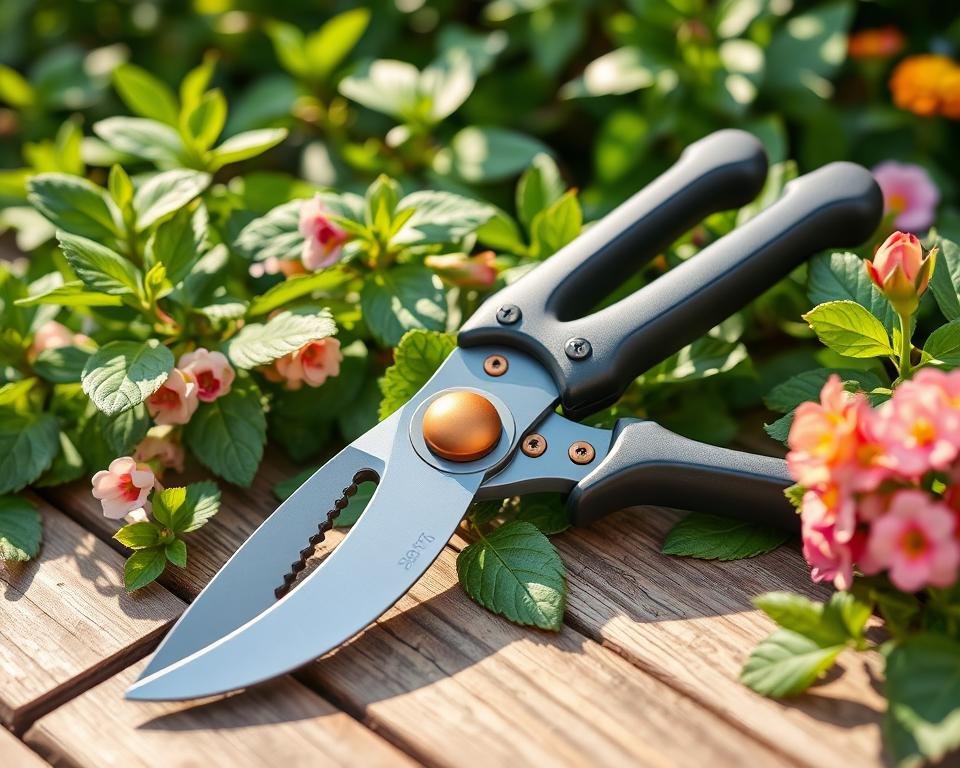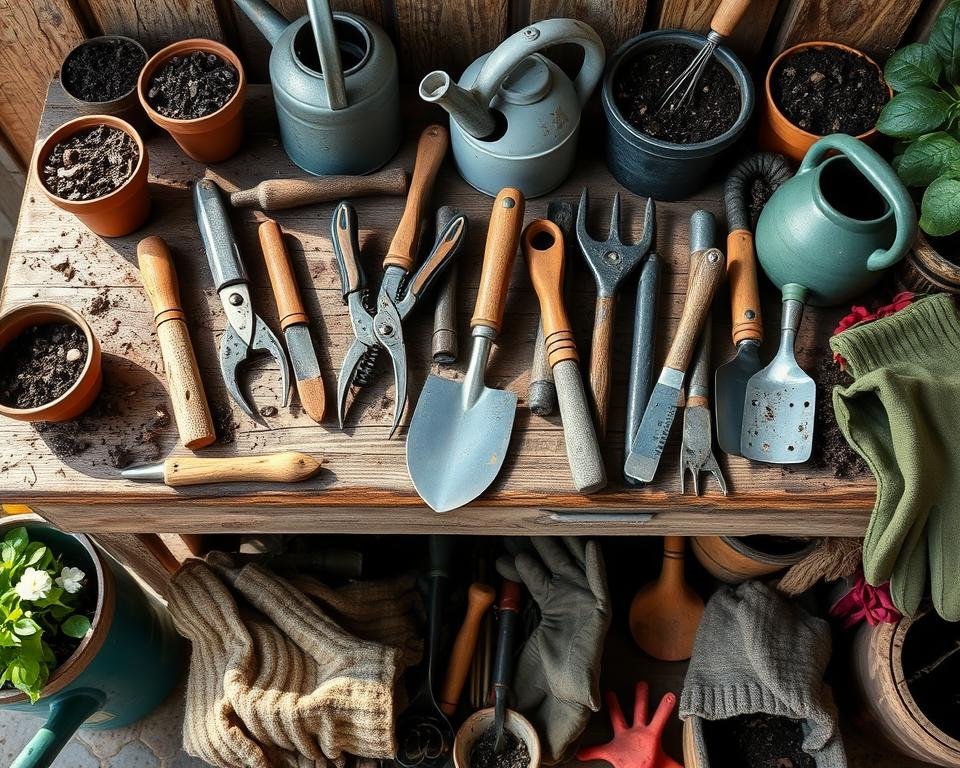Are you ready to tackle your next outdoor project with power tools, but concerned about safety? Look no further! This comprehensive guide will provide you with the essential tips to protect yourself and ensure a successful, injury-free experience in your garden.
Power tools can be incredibly useful for a variety of garden tasks, from trimming hedges to cutting logs. However, they also come with inherent risks that must be addressed. So, what are the crucial steps you need to take to stay safe while using power tools outdoors?
Introduction to Power Tool Safety
Using power tools in the garden or workshop can be efficient for many projects. But, it also comes with risks. It’s important to focus on safety to avoid serious injuries and have a good experience. We’ll look at why safety is key and the dangers of power tools.
The Importance of Safety Precautions
Power tools like saws, drills, and sanders are meant to make our lives easier. But, they can be dangerous if not used right. Not following safety rules can cause deep cuts, broken bones, and even life-threatening accidents. By knowing and using important safety steps, you can keep yourself and others safe from power tool hazards.
Common Power Tool Hazards
The main power tool hazards include:
- Flying debris: Pieces of material like wood or metal can fly fast, hurting your eyes or causing cuts.
- Kickback: When a power tool suddenly moves on its own, it can lead to losing control and getting hurt.
- Entanglement: Loose clothes, hair, or jewelry can get caught in power tools, causing serious harm.
- Electrical shock: Bad wiring or damaged cords can lead to electrical shock, which can be deadly.
Knowing these power tool hazards and taking the right steps is key to a safe workshop safety area. It helps prevent injury prevention.
Personal Protective Equipment (PPE)
When you work with power tools in your garden, wearing personal protective equipment (PPE) is key. It helps lower the risk of getting hurt. The right protective equipment keeps you safe and lets you garden without worry.
Here are the main PPE items you need when using power tools:
- Safety glasses or goggles to protect your eyes from debris and flying particles
- Hearing protection, such as earmuffs or earplugs, to shield your ears from the noise generated by power tools
- Sturdy, slip-resistant work boots to provide stability and protect your feet
- Gloves to protect your hands from cuts, scrapes, and vibrations
- Dust masks or respirators to filter out harmful airborne particles and prevent respiratory injury prevention
Choosing the right PPE is crucial for your safety and comfort. It lets you enjoy gardening with power tools without fear of accidents. By wearing the right gear, you can work confidently and safely.
| PPE Item | Purpose | Key Features |
|---|---|---|
| Safety Glasses | Protect eyes from debris and flying particles | Shatterproof lenses, wraparound design, adjustable fit |
| Hearing Protection | Reduce noise exposure and prevent hearing damage | Noise reduction rating (NRR), comfortable fit, versatile options |
| Work Boots | Provide stability, traction, and foot protection | Steel or composite toe, slip-resistant soles, ankle support |
| Gloves | Protect hands from cuts, scrapes, and vibrations | Reinforced palm and fingers, breathable material, dexterity |
| Dust Mask/Respirator | Filter out harmful airborne particles | NIOSH-approved, comfortable fit, adjustable straps |

Safety Tips for Using Power Tools
Using power tools safely is key for both getting the job done right and avoiding injuries. Whether you’re a pro at DIY or just starting out, picking the right tool and following the right steps is crucial. Here are some important safety tips to keep in mind when using power tools.
Proper Tool Selection and Maintenance
Choosing the right power tool for the job is the first step to safety. Think about what you need to do and pick a tool that’s up to the task without risking your safety. Also, keeping your tools in good shape is important to avoid accidents and malfunctions.
- Check your power tools for damage or wear before each use.
- Follow the maker’s guide for cleaning, oiling, and storing your tools.
- Swap out old or broken parts quickly to keep your tools safe and working well.
Operating Power Tools Safely
After picking the right tool and making sure it’s in good shape, it’s time to focus on how to use it safely. Learn how the tool works and always put safety first.
- Make sure the workpiece is steady to avoid it moving while you’re working.
- Stand steady and keep your body and hands in a safe spot while using the tool.
- Use the tool as the maker says, including the right speed and depth.
- Keep your eyes on the job and avoid distractions that could make you unsafe.
By following these safety tips, you can lower the chance of accidents and injuries when using power tools. Remember, being careful is the best way to stay safe and get the job done well.

| Tool Maintenance | Operating Instructions | Injury Prevention |
|---|---|---|
| Regular inspections | Secure workpiece | Proper tool selection |
| Manufacturer-recommended cleaning and lubrication | Maintain stable stance | Wear personal protective equipment |
| Prompt replacement of worn or damaged parts | Follow operating guidelines | Stay focused and alert |
Electrical Safety Considerations
Electrical safety is key when using power tools. It’s important to know about grounding, circuit breakers, and GFCI outlets. These steps help prevent shock or electrocution. By following these safety tips, you can lower the risk of electrical hazards and injuries in your garden.
Grounding and Circuit Protection
Grounding is a vital safety feature. It helps to move any electrical current away from you. All power tools need to be grounded to keep you safe. Circuit breakers and GFCI outlets also offer protection by cutting off power quickly if there’s an electrical fault.
| Safety Feature | Description | Benefit |
|---|---|---|
| Grounding | Dissipates electrical current away from the user | Reduces the risk of shock or electrocution |
| Circuit Breakers | Automatically shut off power in case of an electrical fault | Prevents electrical fires and protects against shocks |
| GFCI Outlets | Detect ground faults and quickly cut off power | Provides an added layer of protection against electrical hazards |
By making sure your power tools are grounded and using circuit protection, you boost your electrical safety. This helps prevent injury prevention in your garden.
Dust Control and Respiratory Protection
Power tools are key in gardening and DIY projects. But, they can create a lot of dust. This dust can harm your health if not managed well.
Dust can cause lung problems and even serious diseases like silicosis. To stay safe, you need to control dust and wear the right protective gear.
- Use dust collection systems: Look for tools with built-in dust catchers. These systems help keep dust out of the air.
- Wear a respirator: Get a good dust mask or respirator. Choose one that filters out small particles well.
- Ensure proper ventilation: Make sure your workspace has good air flow. Use air cleaners or exhaust systems to improve air quality.
- Clean up thoroughly: Use a vacuum with a HEPA filter to clean your area. Don’t sweep or blow dust, as it can spread.
By focusing on dust control and wearing protective gear, you keep yourself safe. This makes your work area better and safer. Remember, these steps help prevent injuries and make using power tools safer and more fun.
| Dust Control Method | Effectiveness | Ease of Implementation |
|---|---|---|
| Dust Collection System | High | Moderate |
| Respirator/Dust Mask | High | High |
| Ventilation | Moderate | Moderate |
| Thorough Cleaning | High | High |
Tool Guards and Safety Features
Power tools come with safety features and guards to keep users safe. It’s important to know how these work to avoid injuries.
Understanding Safety Mechanisms
One key safety feature is the blade guard. It covers the blade to protect hands and body from cuts. The guard should always be in good shape and work right.
The emergency stop switch, or “kill switch,” is another vital feature. It lets users quickly stop the tool in an emergency. Make sure to test and keep the kill switch working well.
Anti-kickback devices are also crucial. They stop the tool from kicking back towards the user. These devices work by sensing sudden changes in the tool’s movement and stopping the blade or action.
| Safety Feature | Purpose | Proper Use |
|---|---|---|
| Blade Guard | Covers exposed blade or cutting edge | Ensure it is in good working condition and retracts properly |
| Emergency Stop Switch | Allows quick power shut-off in emergencies | Test regularly to ensure reliable operation |
| Anti-Kickback Device | Detects sudden changes in tool motion and stops blade/cutting action | Maintain device as per manufacturer’s instructions |
Using tool guards and safety features right can greatly lower injury risks. This is true whether you’re in the garden or workshop.
Workshop Organization and Housekeeping
Keeping your workshop clean and organized is key for safety and preventing injuries. A clutter-free space, where tools and materials are stored properly, and good lighting, makes work safer and more efficient. This setup reduces the chance of accidents and mishaps.
Organizing your tools and materials is crucial. It prevents tripping and makes finding the right tool easier. This reduces the risk of accidents from using the wrong tool. Also, cleaning regularly helps spot safety issues, like damaged equipment.
Good lighting is also vital for safety. It prevents eye strain and improves visibility. This makes spotting hazards easier and working with power tools safer. Adding more lights or task lamps can make your workshop safer and more conducive to work.
FAQ
What are the most important safety precautions to take when using power tools in the garden?
Wearing the right protective gear is key. This includes safety glasses, ear protection, and gloves. Choose the right tool for the job and keep it in good shape. Always follow the instructions from the manufacturer.
Make sure your electrical outlets are safe and use GFCI protection. Keep your workspace clean and organized to avoid accidents.
What are the common hazards associated with power tool use?
Hazards include flying debris, kickback, and electrical shock. Dust can also be a problem. Knowing these risks helps you stay safe.
What personal protective equipment (PPE) should I wear when using power tools?
You need safety glasses, ear protection, gloves, and sturdy shoes. Depending on the task, a dust mask might be necessary too.
How do I properly select and maintain my power tools?
Choose the right tool for the job and keep it in good condition. Read the instructions and pick tools that fit your needs. Regularly clean and maintain your tools.
What electrical safety precautions should I take when using power tools?
Electrical safety is crucial. Use grounded outlets and GFCI-protected circuits. Keep power cords in good shape. Avoid using tools in wet conditions.
How can I effectively control dust generated by power tools?
Use tools with dust collection systems. Work in well-ventilated areas. Wear a respirator or dust mask to protect your lungs.
Why is it important to understand the safety features and guards on my power tools?
Safety features like blade guards and emergency stops are there to protect you. Knowing how they work helps prevent accidents.
What are some best practices for maintaining a safe and organized workshop when using power tools?
A clean and organized workshop is essential. Keep the area clutter-free and well-lit. Store tools and materials properly. Good ventilation is also important.

